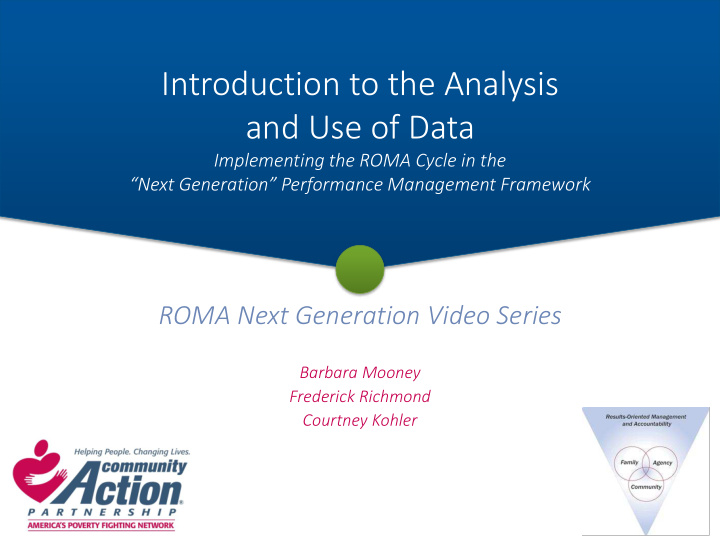



Introduction to the Analysis and Use of Data Implementing the ROMA Cycle in the “Next Generation” Performance Management Framework ROMA Next Generation Video Series Barbara Mooney Frederick Richmond Courtney Kohler
ROMA Next Generation Video Series Understanding Creating a Setting the Introduction to Implementing Community Local Theory of Stage for Data Analysis and the Full ROMA Level Work Change Collection Use of Data Cycle
What is “Data”? Facts or a set of well defined distinct objects (such as numbers or responses) that can be used for some practical purpose.
Raw Data • “Raw” or “Unprocessed” data is a list of facts, numbers or other qualitative or quantitative “elements”. • The raw data have some basic meaning but need to analyzed to turn them into information.
Data, Information, and Knowledge • Data is facts that are observed, measured, collected and can be aggregated. • Data only becomes information for decision making once it has been analyzed in some fashion. • Knowledge is derived from the interaction of information and experience with a topic.
For Example Data: 29,029 feet, location, climate, terrain. Information: Using the combination of data elements to understand the conditions on the mountain. Knowledge: Understanding how the information is related to the task of climbing and survival of the climber .
Basic Collection and Analysis Cycle Collect data Make decisions Enter data based on into storage information Retrieve and Turn data aggregate into data information elements
Once you have collected and stored your data - You want to inspect and “clean” the data elements - Remove outliers - Identify obvious errors - Question missing data
Aggregate the Data - Bring the data elements together - Define, clarify the context - Make comparisons - Create visualization Strawberry wins!
Flawed Data →
What if the Data is Flawed? • Waste of time and money • False impressions • Poor forecasts • Devalues decisions that follow
Turn Data into Information So that you can USE the data to increase knowledge and improve decision makings
Varieties of Data Analysis Data mining Business intelligence Descriptive statistics Exploratory Confirmatory Forecasting Text analytics
Data Analysis Figures Facts Stories Useful Information
Count How many? This is a most important question!
What will you be counting? • Number of individuals and families served • Number of services delivered • Number of outcomes achieved by those receiving services
What does the count mean? • You will want to know if the numbers you have produced are “good”. • In some cases, funding sources will only be looking for your counts. • However, with a “results orientation” our network also wants to know what the counts mean.
Comparing Data One important analysis technique with many different approaches
Compare Projected and Actual Compare the actual program data with the projections you made at the beginning of the year – How many projected to serve? – How many actually served? – How many projected to achieve an outcome? – How many actually achieved the outcome?
Longitudinal Comparisons Compare program data from year to year – Quantity of service – Population served – Cost of program – Outcomes achieved
Compare Local and National Data From the National IS Data we know that the population served across the country is: – Very low income (below 50% FPG) – 1/3 are children – 1/3 fixed income,1/3 pubic benefits, 1/3 employment • How does your client population compare?
Compare with Needs Assessment • Refer back to your Assessment data. • Remember what you identified about the needs. • Then consider: Did you impact the needs?
Compare With Other Agencies – What do other agencies who have similar outcomes achieve? – How are services delivered in the other agency as compared to how we deliver our services? – Are our populations similar?
Identify the Trend Looking at data elements over time will produce a “trend line”
Identification of Trends Are things changing? Staying the same ? • Demographics • Opportunities for employment; kinds of businesses • Environmental changes • Opportunities for recreation • Availability of health care professionals, facilities and systems
Explore the Trend
Using Information from Data Analysis to Make Decisions The analysis of your data should lead to your agency maintaining or improving quality services and producing outcomes
Avoid Making Conclusions Without All the Facts • What happens if you compare two data elements that may be related, but are not dependent on one another? • How can you identify if there are other data elements that should be included in your analysis?
Ice Cream and Drowning Drowning JAN FEB MARCH APRIL MAY JUNE JULY AUG SEPT OCT NOV DEC Ice Cream Sales JAN FEB MARCH APRIL MAY JUNE JULY AUG SEPT OCT NOV DEC
Summary Thoughts • Be sure your data is “clean” (accurate, complete, timely) • Count • Compare • Look at Trends • Identify what else you need to know.
NEXT STEPS
www.communityactionpartnership.com
For More Information Barbara Mooney, Director Association of Nationally Certified ROMA Trainers barbaramooney@windstream.net Frederick Richmond, President The Center for Applied Management Practices frichmond@appliedmgt.com Courtney Kohler, Senior Associate Community Action Partnership ckohler@communityactionpartnership.com Jarle Crocker, Director T/TA Community Action Partnership jcrocker@communityactionpartnership.com
Recommend
More recommend